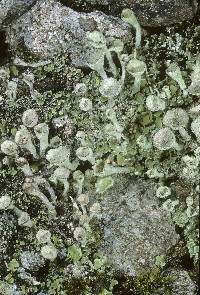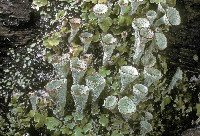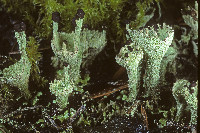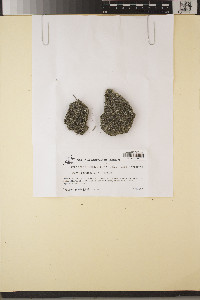
Consortium of Lichen Herbaria
- building a Global Consortium of Bryophytes and Lichens as keystones of cryptobiotic communities -
- Home
- Search
- Images
- Species Checklists
- US States: O-Z >
- US National Parks
- Central America
- South America
- US National Parks
- Southern Subpolar Region
|
|
|
|
Family: Cladoniaceae
|
Nash, T.H., Ryan, B.D., Gries, C., Bungartz, F., (eds.) 2002. Lichen Flora of the Greater Sonoran Desert Region. Vol 1. Primary thallus: squamulose, persistent or disappearing, glaucescent green or glaucescent blue-green to olivaceous or brown above, often pruinose along margins; squamules: 2-3 mm long, 1-2 mm wide, esorediate or with granular soredia beneath margins podetia: produced from upper side of primary squamules, borne singly or with several podetia emerging from one squamule, cup-forming, 5-35 mm tall; cups: 3-8 mm wide, flaring abruptly surface: farinose to granularly sorediate; soredia: giving rise to isidioid-flattened squamules toward bases Apothecia: on margins of cups, 1-4 mm wide, brown ascospores: not observed Pycnidia: at cup margins, pyriform, constricted at base, with hyaline gelatin conidia: not observed Spot tests: K- or K+ dingy yellowish, changing to brownish, C-, KC-, P+ red, UV- Secondary metabolites: fumarprotocetraric, rangiformic and/or norrangiformic acids (north of the Sonoran area chemotypes with lichesterinic and/or protolichesterinic acid or fumarprotocetraric acid alone are also known). Habitat and ecology: on twigs, rotting stumps, tree bases, thin soil, and sometimes over sand dunes, generally at lower elevations, mainly occurring in temperate, oceanic habitats World distribution: Asia (Ural Mountains), Europe, North America (west) and South America (southern portion) and Antarctica Sonoran distribution: southern California; reported from Los Angeles and Santa Barbara Counties by Hammer (1995). Notes: Cladonia asahinae is generally included in the so-called C. chlorophaea complex and is characterized by presence of aliphatic acids (rangiformic or lichesterinic acid complexes, both identified with TLC if concentrations are sufficient [Culberson et al. 1986; Hennings 1983; Holien and Tønsberg 1985]). The lichesterinic acid chemotype is more frequent in California (Hammer 1995). Brodo and Ahti (1997) included some material without these acids, relying on morphology alone. Hennings (1983) and Hammer (1995) suggested that the chemotypes may sometimes be distinguishable by morphology or thallus color. This species is very common on the coast of Pacific Northwest, where one can learn to recognize it with some difficulty by its brownish, broadly cupped podetia, that are finely to coarsely sorediate or granulose and that tend to have toothed cup rims. However, C. asahinae is still a very poorly known and much overlooked species. |
|
|
|
Powered by Symbiota








































